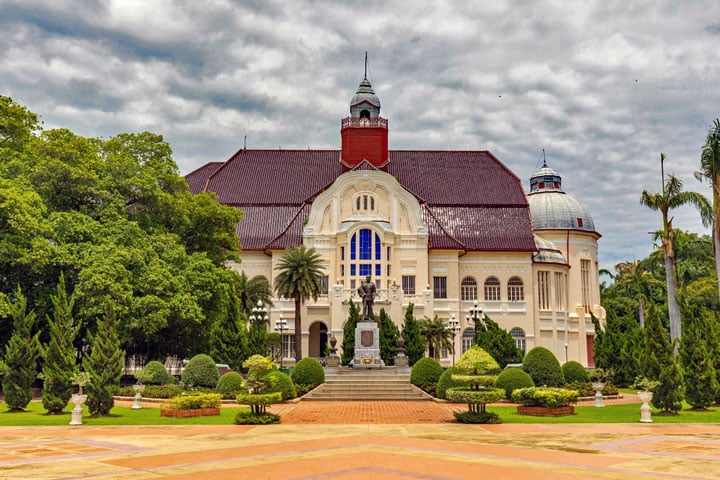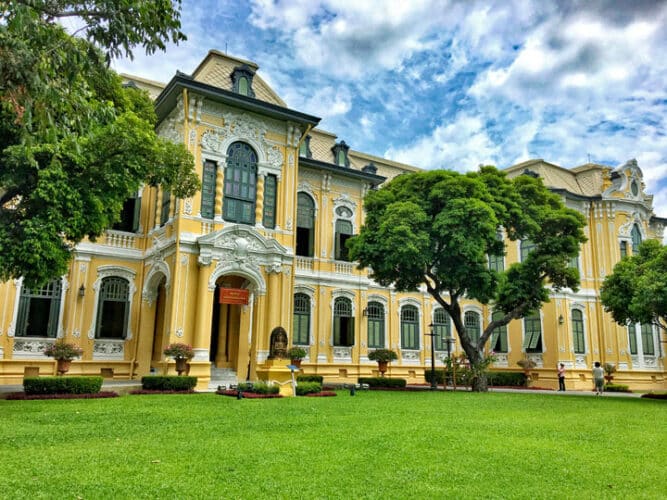
Karl Dohring
In the two previous contributions about foreign influences in Siamese and Thai architecture, I paid attention to the Italians. I like to conclude by taking a moment to reflect on the intriguing figure of the German architect Karl Döhring. He did not produce nearly as much as the aforementioned Italians, but the buildings he erected in Siam are, in my humble opinion, among the most beautiful in terms of the strange mix between local and farang-architecture could provide.
As if that were not enough, Döhring has gone down in history as one of the guardians of the Siamese heritage, who not only carried out the necessary studies in this regard, but also published those studies for the benefit of future generations. Not only did he stimulate interest in Siam among a German readership, but his detailed drawings and photographs proved invaluable to the Thai Department of Fine Arts a few decades later during the first major restoration and conservation operations.
Karl Siegfried Döhring – whose name was often misspelled as Döring – was born on August 14, 1879 in Cologne in the family of a clerk of the Imperial Post Office. He did not follow in his father's footsteps because Karl Siegfried was apparently interested in art and architecture at a young age. After he had completed his secondary education in Neustetin - where the family had meanwhile moved - he immediately chose to study architecture at the renowned Konigliches Technische Hochschule in Berlin - Charlottenburg, where some of the most famous Berlin architects such as Julius Raschdorff and Otto Schmalz belonged to belonged to the teaching staff. Döhring was a very ambitious student who, in addition to studying architecture, was also enrolled at von Humboldt University for courses in art history, archeology and philosophy.
During his studies he became fascinated by Southeast Asian art and architecture in general and Burmese in particular. After he died in 1905 cum laude graduated from Charlotteburg, he almost immediately applied for a job with the Siamese government. Already in May 1906 he arrived in Bangkok with his brand new bride Margarethe Erbguth, where he started working as an engineer at the Railways two months later. A department that was in full development and, coincidentally or not, since 1891 in the hands of German chief engineers. Louis Wieler, who in 1906 called the shots at the Siamese Railways was, coincidentally or not, a former student of the Konigliches Technische Hochschule in Charlottenburg… For the railways he not only designed a number of bridges, depots and workshops, but also the old -bombed to pieces during WWII – Thonburi station and the station building of Phitsanulok.

Phra Ram Ratchani Law
In September 1909, King Chulalongkorn commissioned him to build a palace, the Phra Ram Ratchaniwet Palace, in Phetchaburi. After Chulalongkorn approved the plans in April 1910, work started almost immediately, but it would take until 1916 before this palace was fully ready for use. Chulalongkorn himself had died on October 23, 1910, but his son and heir to the throne Vajiravudh continued to supervise the construction project. The striking two-storey building was built on a rectangular ground plan with a very high mansard roof. In terms of style, the palace is a beautiful testimony to the Jugendstil, but in terms of decorative elements, including the colorful tiling, there is also a clear start towards Art Deco, but also with sturdy pillars and barrel vaults that were inspired by those of the Romanesque churches in Döhrings youth in the Rhine region. Döhring was particularly influenced by the British Aries & Crafts movement, but also by the Jugendstil of the Deutscher Werkbund founded in 1907 by Muthesius, Behrens and the Fleming Henry van de Velde. What makes this building completely unique is that it was one of the first buildings in Southeast Asia to be built from reinforced concrete and the first civilian building in Siam with a steel roof construction. The complex is currently on military grounds, but it is accessible. A small exhibition has been set up in the building where you can find, among other things, Döhring's original building plans.

Bang Khun Phrom Palace (ajisai13 / Shutterstock.com)
What makes Döhrings' oeuvre so unique is that, unlike many others farangarchitects who were active in Bangkok and the surrounding area in those days, did not blindly introduce Western style elements, but that he constantly went in search of a subtle style balance between East and West. The best example of this is, in my opinion, the so-called Varadis Palace, in reality rather a majestic villa on Lan Luang Road. Döhring designed this building as the residence of Prince Damrong, Chulalongkorn's powerful half-brother who had served as Minister of the Interior and Minister of Education, among other things. He designed a very elegant villa that was built between 1910 and 1911, mixing the best elements of Art Nouveau with Chinese architecture. Today it houses a library and museum dedicated to Damrong's intriguing life. Equally impressive and testifying to Döhrings' creativity and sense of style interpretation were the buildings he designed for the Ban Khun Phrom Palace. In particular, the Tamnak Somdej Wing, which was completed in 1913 for Queen Sukhumala Marasri, the sixth wife of Chulalongkorn, bears witness to an architectural sophistication and class rarely seen in Bangkok to this day.

Portrait of Döhring in the collection of the British Libraray
Nothing stood in the way of Döhrings' career until, at the end of March 1911, disaster struck hard. His young wife suddenly died of cholera in Bangkok. Torn by this tragedy, he took a year's leave and left for the Heimat in June 1911. When he returned to Bangkok in the summer of 1912, he had not only obtained a doctorate in civil engineering from the University of Dresden with a dissertation Das Phrachedi in Siam, but he was also accompanied by his second wife, Käthe Jarosch. In addition to supervising his yards and new, partly archaeological, researches, often in the company of Prince Damrong, in Isaan and the north, he also drew up the plans for a new university, but the latter were never materialized for reasons that are unclear. This may have been one of the reasons why he increasingly fell victim to bouts of depression and even full-blown depression. As if all this misery were not enough, he suffered a considerable financial loss due to the abandonment of a number of other assignments, which plunged him even deeper into a valley... King Rama VI, who apparently could no longer bear to watch one of his favorite architects mentally threaten to fall under provided him with a stipend, a fixed monthly income. He also gave him permission to recharge the batteries in Germany.
When Döhring left the Chao Phraya at the end of September 1913, he could not have imagined that he would never see his beloved Siam again… In February 1914 he obtained his doctorate magna cum laude from the University of Erlangen to a doctorate in philosophy with his thesis Der Bôt (Haupttempel) in the siamesische Tempelanlagen, a 66-page cultural history study, which was published in May of the same year.
Originally he should have returned to Siam in the summer of 1914, but the outbreak of the First World War put a stop to that. He was mobilized as a reserve officer and assigned to a hot-air balloon unit as an artillery observer. He must have been deployed at the front because he was decorated with the Iron Cross IIe class. However, this did not prevent him from obtaining his doctorate with a dissertation during the Great War, in 1916 to be precise Der Verzicht im öffentlichen Recht to a doctorate in law from the University of Greifswald. He then began to study philology and theology, but it is not clear whether he actually completed these studies.
After the war, German architects and engineers were no longer well positioned in the Siamese market. Siam had joined the Allied camp in June 1917 and had all German residents interned. Döhrings' chief, Louis Wieler, was one of the German expatriates who died in January 1918 off the coast of Africa during his repatriation aboard a Danish ship. Döhrings' close colleague, the engineer Eisenhofer with whom he had worked on the development of the so-called Northern Railway, had already died in the spring of 1914 during the construction of the Khuntan tunnel near Lampang. Döhring hoped for a quick return, but gradually he realized that this would not be immediately. To make matters worse, his marriage to Käthe Jarosch also fell apart.
Perhaps Döhring was looking for an outlet for his problems and devoted himself to writing cultural-historical publications about India and Siam. Between 1920 and 1923 he published the standard work, consisting of three volumes Buddhist Temple Anlagen in Siam at Asia Publishing House. This richly illustrated work is still one of the reference works when it comes to the architecture of 18e in 19. e century Siamese temple complexes and is regarded as one of the best cultural-historical studies ever conducted by a farang about Siamese architecture were published.

Cover of one of Döhring's historical novels
In 1923 it rolled at the Folkwang Verlag Siam: That bildende Kunst from the press. Followed two years later Art and Crafts in Siam: Lacquer work in black and gold at Julius Bard Verlag. Döhring was an author who proved to be at home in many markets. His novel was published in 1927 Im Schatten Buddhas: Roman eines siamesischen Prinzen under the exotic sounding pseudonym Ravio Ravendro.
A few years later, he re-wrote the historical novel as Ravi Ravendro Flight from Buddhas Gesetz – Die Liebe des Prinzessin Amarin. Döhring, however, introduced this book under his own name as follows: “Die schönste Zeit meines Lebens verbrende ich in Siam, wo ich vor dem Kriegelange Regierungsbeamter war. Nach einem Studium in mehreren Fakultäten wurde ich auf mein Gesuch hin nach Bangkok gerufen. Unter der Regierung der Herrscher Chulalongkorn und Vajiravudh baute ich mehrere Palais für den König und für die Prinzen des Königlichen Hauses, und während meines Aufenthaltes in diesem letzten unabhängigen Buddhists Königreich lernte ich die hohe, Verfeinerte Kultur des siamesischen Hofes. Ich versuchte in diesem Roman, etwas von der Schönheit und Eigenart Siams mitzuteilen…“
Ravo Ravendro was by no means his only one pen name for he also published under the names Hans Herdegen and Dr. Hans Barbeck mainly translates from English, with a preference for the work of Edgar Wallace, who was extremely popular in Germany – the inventor of the modern thriller – of whom he translated at least sixty-four books. He must have translated and written at an incredibly fast pace because there are more than two hundred and fifty titles known that Döhring has translated from English….
Karl Döhring's rich life came to an end on August 1, 1941 when, forgotten by the outside world, he died almost anonymously in a hospital in Darmstadt.


Look, I can appreciate this architectural style, the first time I saw it I immediately thought of Thai architecture with obvious influence from central or eastern Europe. Conversely, it could also be in Germany or St. Petersburg with inspiration from Siam. Influencing each other back and forth and then puzzling to combine the finest qualities from both backgrounds into something new.
@Rob V.,
“Influencing each other back and forth and then puzzling to combine the finest qualities from both backgrounds into something new.”
It looks quite like a political metaphor with a preference for a former Eastern European sauce.